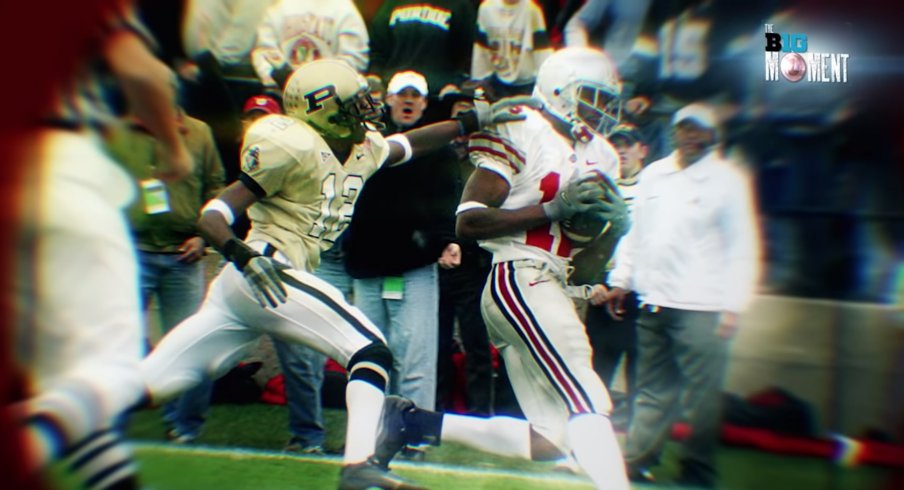Three-star in-state linebacker CJ Sanna commits to Ohio State.
The Big Ten Network aired its "Holy Buckeye" feature on Saturday night, which showcased one of Ohio State's signature plays during the 2002 national title season.
The Buckeyes were 10-0 heading into their matchup on the road vs. Purdue that year. Third-ranked Ohio State was supposed to walk over an unranked Boilermakers team, but the game unfolded as a low-scoring defensive battle that came down to the wire.
You know how this story ends. Craig Krenzel found Michael Jenkins via a 37-yard touchdown pass with less than two minutes to play — the only touchdown in a game the Buckeyes won 10-6.
Here are four things we learned from the Big Ten Networks showcase of the iconic play.
Craig Krenzel Thought He was Going To Score on His Red-Zone Run Late in the Second Quarter
The only points Ohio State got in the first half against Purdue came on a last-second field goal before the break that, as Ramzy pointed out in his latest "My Favorite Things" article, probably wouldn't have been tallied in the camera review era.
The play before Ohio State's field goal attempt was a seven-yard scramble from quarterback Craig Krenzel. In the moment, everyone wondered why Krenzel would scramble knowing Ohio State had no timeouts with 19 seconds remaining. The former Ohio State quarterback offered his explanation on the show.
"I thought, stupidly, that there was gonna be more there than there was and that maybe I had a chance to score," Krenzel explained. "Really, really poor decision."
Michael Jenkins Had A Little Bit of Chris Gamble Energy
I can't be the only one who doesn't remember Michael Jenkins making an impact in obscure special teams situations.
That distinction — the do-it-all, play with any position group attitude — will always belong to Chris Gamble, who routinely played north of 100 plays on offense, defense and special teams any given Saturday.
But on the Big Ten Network's showcase of the Ohio State - Purdue game, they highlighted a side of Jenkins that's hard to recall.
"Michael Jenkins, he would just do whatever you asked him to do," Tressel said. "He'll catch punts, block punts, block for kickoffs, he doesn't care."
Eighteen years later, it's hard to remember Jenkins' contributions outside of being one of the program's all-time great receivers. But his key punt block in the second half helped keep the momentum in balance.
Chris Gamble Ran the Wrong Route on Ohio State's Go-Ahead Touchdown
It's amazing how much didn't go the way Ohio State expected on this iconic play.
One thing that didn't make the show, but rather one of the promotions the Big Ten Network aired, is that Chris Gamble ran the wrong route on Ohio State's touchdown play.
Krenzel to Jenkins...@OhioStateFB fans, don't miss the "Holy Buckeye" #B1GMoment as it debuts night at 8 PM ET on BTN. pic.twitter.com/6PwrlbQDdV
— Ohio State on BTN (@OhioStateOnBTN) July 24, 2020
You can even see Krenzel look to his right at Gamble on the very last step of his drop back, before stepping up and committing to the down-field throw to Jenkins.
King Right 64 Y Shallow Swap Was A Routine, Staple Play, and It Wasn't Supposed to be a Touchdown
Maybe this wasn't news to those among us who understand the intricacies of the X's and O's, but former Ohio State head coach Jim Tressel admitted on the show that the play they drew up on fourth-and-one was a routine play they called as frequently as 10 times in a given game, and it wasn't supposed to be a shot at the end-zone.
That play always stood out as so uncharacteristic because it went against the conservative approach Tressel brought to game day. But it was only the situation that made it so uncharacteristic, not the actual play itself.
But when Tressel called it, he wasn't envisioning Michael Jenkins abandoning his post-route for a go-route. The first and immediate read was tight end Ben Hartsock's short, shallow route across the middle that was picked up by a linebacker. As the pocket collapsed, Krenzel stepped up and potentially had a lane to run for the needed yard, but he ultimately decided to trust Jenkins down the field.
The rest, as they say, is history.


